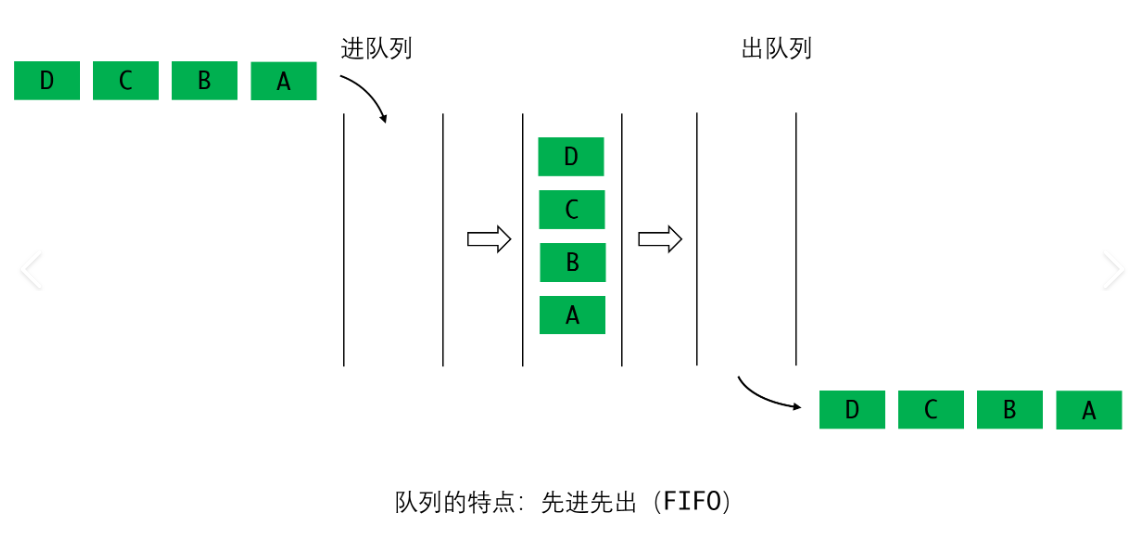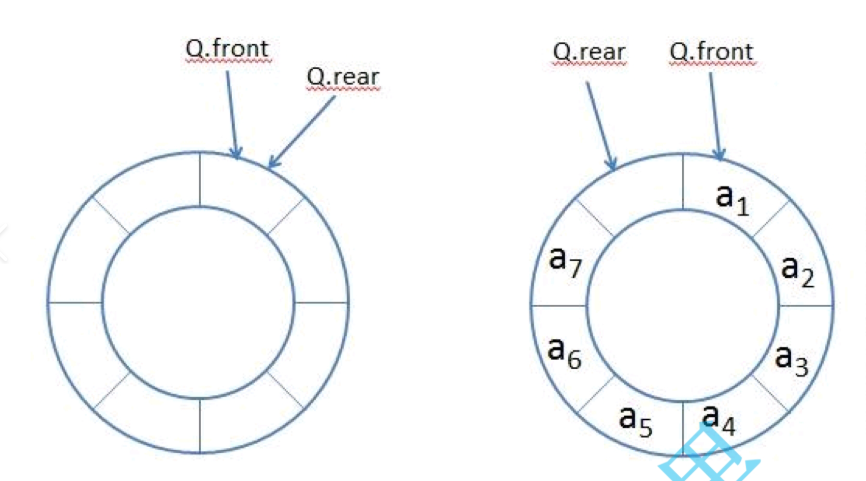一、队列是什么?------ 从生活到技术的 "先进先出" 模型
队列(Queue)是一种遵循 "先进先出"(First In First Out, FIFO) 规则的线性数据结构,类比生活中 "排队买票" 的场景:先排队的人先买票,后排队的人后处理,不允许 "插队" 或 "提前离开"。
在技术场景中,队列的核心特性可概括为:
- 两端操作限制:仅允许在 "队头(Front)" 取出元素(出队),在 "队尾(Rear)" 添加元素(入队);
- 顺序严格性:元素的处理顺序与添加顺序完全一致,无优先级反转;
- 抽象数据类型 :需支持
初始化(init)、入队(enqueue)、出队(dequeue)、判空(is_empty)、销毁(destroy)等基础操作。

二、队列的两种经典实现 ------ 数组 vs 链表
C/C++ 中无原生队列结构,需基于数组或链表手动实现,两种方式各有优劣,需根据场景选择。
1. 数组实现:循环队列(解决 "假溢出" 问题)
普通数组队列存在 "假溢出" 缺陷 ------ 队尾已达数组末尾,但队头前仍有空闲空间。循环队列通过 "取模运算" 将数组首尾相连,让空间循环利用,是数组队列的最优实现。
(1)数据结构定义
#include <stdio.h>
#include <stdlib.h>
#include <stdbool.h>
// 定义队列元素类型(可根据需求修改,如int、结构体)
typedef int QueueData;
// 循环队列结构体
typedef struct {
QueueData* data; // 存储元素的数组
int front; // 队头索引(指向第一个元素)
int rear; // 队尾索引(指向最后一个元素的下一个位置)
int max_size; // 队列最大容量
} CircularQueue;关键设计 :数组容量设为 max_size + 1,用 "(rear + 1) % (max_size + 1) == front" 判断队列满,避免与空队列(front == rear)混淆。

(2)核心操作实现
① 初始化队列
// 初始化循环队列,max_size为最大容量
CircularQueue* queue_init(int max_size) {
// 申请队列结构体内存
CircularQueue* q = (CircularQueue*)malloc(sizeof(CircularQueue));
if (q == NULL) {
printf("队列内存分配失败!\n");
return NULL;
}
// 申请元素数组内存(预留1个空位区分空/满)
q->data = (QueueData*)malloc(sizeof(QueueData) * (max_size + 1));
if (q->data == NULL) {
printf("元素数组内存分配失败!\n");
free(q); // 释放已分配的结构体
return NULL;
}
q->front = 0;
q->rear = 0;
q->max_size = max_size;
return q;
}② 判空与判满
// 判断队列是否为空
bool queue_is_empty(CircularQueue* q) {
if (q == NULL) return true;
return q->front == q->rear; // 空队列标志:队头=队尾
}
// 判断队列是否已满
bool queue_is_full(CircularQueue* q) {
if (q == NULL) return false;
// 满队列标志:队尾下一个位置=队头(取模实现循环)
return (q->rear + 1) % (q->max_size + 1) == q->front;
}③ 入队(添加元素)
// 入队:将data添加到队尾,成功返回true,失败(满)返回false
bool queue_enqueue(CircularQueue* q, QueueData data) {
if (q == NULL || queue_is_full(q)) {
printf("队列已满或未初始化,入队失败!\n");
return false;
}
q->data[q->rear] = data; // 元素存入队尾
q->rear = (q->rear + 1) % (q->max_size + 1); // 队尾循环后移
return true;
}④ 出队(取出元素)
// 出队:从队头取出元素存入*data,成功返回true,失败(空)返回false
bool queue_dequeue(CircularQueue* q, QueueData* data) {
if (q == NULL || queue_is_empty(q) || data == NULL) {
printf("队列为空、未初始化或指针无效,出队失败!\n");
return false;
}
*data = q->data[q->front]; // 取出队头元素
q->front = (q->front + 1) % (q->max_size + 1); // 队头循环后移
return true;
}⑤ 销毁队列(避免内存泄漏)
// 销毁队列,释放所有内存
void queue_destroy(CircularQueue* q) {
if (q != NULL) {
if (q->data != NULL) {
free(q->data); // 先释放元素数组
}
free(q); // 再释放队列结构体
}
}(3)使用示例
int main() {
CircularQueue* q = queue_init(5); // 初始化容量为5的队列
if (q == NULL) return 1;
// 入队:10、20、30
queue_enqueue(q, 10);
queue_enqueue(q, 20);
queue_enqueue(q, 30);
// 出队并打印
QueueData val;
while (!queue_is_empty(q)) {
queue_dequeue(q, &val);
printf("出队元素:%d\n", val); // 输出:10 → 20 → 30
}
queue_destroy(q); // 销毁队列
return 0;
}2. 链表实现:动态队列(无容量限制)
链表队列用节点存储元素,通过指针连接节点,容量可动态扩展,无需提前指定大小,适合元素数量不确定的场景。
(1)数据结构定义
#include <stdio.h>
#include <stdlib.h>
#include <stdbool.h>
typedef int QueueData;
// 链表节点结构体
typedef struct QueueNode {
QueueData data; // 节点存储的元素
struct QueueNode* next; // 指向后一个节点的指针
} QueueNode;
// 链表队列结构体
typedef struct {
QueueNode* front; // 队头指针(指向第一个节点)
QueueNode* rear; // 队尾指针(指向最后一个节点)
int size; // 队列元素个数(可选,方便快速查询)
} LinkedQueue;(2)核心操作实现
① 初始化队列
c
运行
LinkedQueue* linked_queue_init() {
LinkedQueue* q = (LinkedQueue*)malloc(sizeof(LinkedQueue));
if (q == NULL) {
printf("队列内存分配失败!\n");
return NULL;
}
q->front = NULL;
q->rear = NULL;
q->size = 0;
return q;
}② 入队(创建新节点)
bool linked_queue_enqueue(LinkedQueue* q, QueueData data) {
if (q == NULL) {
printf("队列未初始化,入队失败!\n");
return false;
}
// 1. 创建新节点
QueueNode* new_node = (QueueNode*)malloc(sizeof(QueueNode));
if (new_node == NULL) {
printf("节点内存分配失败,入队失败!\n");
return false;
}
new_node->data = data;
new_node->next = NULL; // 队尾节点next为NULL
// 2. 插入队列(空队列 vs 非空队列)
if (q->size == 0) {
q->front = new_node; // 空队列:队头=队尾=新节点
q->rear = new_node;
} else {
q->rear->next = new_node; // 非空队列:队尾next指向新节点
q->rear = new_node; // 更新队尾
}
q->size++;
return true;
}③ 出队(删除队头节点)
bool linked_queue_dequeue(LinkedQueue* q, QueueData* data) {
if (q == NULL || q->size == 0 || data == NULL) {
printf("队列为空、未初始化或指针无效,出队失败!\n");
return false;
}
// 1. 保存队头节点和数据
QueueNode* temp = q->front;
*data = temp->data;
// 2. 更新队头(仅一个节点 vs 多个节点)
if (q->front == q->rear) {
q->front = NULL; // 仅一个节点:出队后队列为空
q->rear = NULL;
} else {
q->front = q->front->next; // 多个节点:队头后移
}
// 3. 释放原队头节点内存
free(temp);
q->size--;
return true;
}④ 销毁队列(遍历释放节点)
void linked_queue_destroy(LinkedQueue* q) {
if (q == NULL) return;
// 遍历所有节点,逐个释放
QueueNode* current = q->front;
while (current != NULL) {
QueueNode* temp = current;
current = current->next;
free(temp);
}
free(q); // 释放队列结构体
}三、两种实现方式对比 ------ 如何选择?
| 对比维度 | 数组队列(循环) | 链表队列(动态) |
|---|---|---|
| 容量限制 | 固定容量(需提前指定) | 动态扩展(无限制) |
| 时间复杂度 | 入队 / 出队均为 O (1) | 入队 / 出队均为 O (1) |
| 空间复杂度 | O (n)(预分配数组) | O (n)(仅存储实际元素) |
| 访问效率 | 随机访问快(数组特性) | 需遍历访问(指针跳转) |
| 适用场景 | 已知最大容量、高频访问 | 容量不确定、频繁增减元素 |
四、队列的典型应用场景
队列的 FIFO 特性使其在 "顺序处理""缓冲平衡" 场景中不可或缺,常见应用包括:
1. 任务调度(操作系统)
- 操作系统的 "进程调度""线程池任务队列":按任务提交顺序依次执行,避免优先级反转(普通队列);
- 打印队列:多任务共享打印机时,按请求顺序排队打印,防止文档混乱。
2. 数据缓冲(通信 / IO)
- 串口 / 网络通信:接收端用队列暂存流式数据,平衡 "数据接收速率" 与 "解析速率",避免数据丢失;
- 磁盘 IO 缓冲:将多次小 IO 请求合并为一次大请求,用队列暂存请求,提升 IO 效率。
3. 算法辅助(BFS / 层次遍历)
- 广度优先搜索(BFS):在图 / 树的遍历中,用队列存储 "待访问节点",确保按层次顺序遍历(如迷宫最短路径、二叉树层次遍历);
- 滑动窗口:用队列维护窗口内的元素,实现窗口滑动时的快速添加 / 删除(如 "无重复字符的最长子串" 问题)。
4. 生产者 - 消费者模型
- 多线程编程中,"生产者" 线程生产数据并入队,"消费者" 线程从队列取数据并处理,队列作为 "数据枢纽",解耦生产者与消费者,平衡两者速率。
五、常见问题与注意事项
-
内存泄漏风险:
- 数组队列:销毁时需先释放
data数组,再释放队列结构体; - 链表队列:必须遍历所有节点释放内存,避免仅释放结构体导致节点内存泄漏。
- 数组队列:销毁时需先释放
-
循环队列的 "空 / 满" 判断:
- 务必预留 1 个空位,用
(rear+1)%(max_size+1) == front判断满,否则无法区分空和满。
- 务必预留 1 个空位,用
-
线程安全问题:
- 多线程环境下,队列的入队 / 出队操作需加互斥锁(如 C++ 的
std::mutex),避免并发访问导致的数据错乱。
- 多线程环境下,队列的入队 / 出队操作需加互斥锁(如 C++ 的
五、进阶示例:
基础字符串链表队列(动态内存管理 + 安全操作)
1. 数据结构定义
#include <stdio.h>
#include <stdlib.h>
#include <string.h>
#include <stdbool.h>
// 链表节点:存储动态字符串
typedef struct StrQueueNode {
char* str; // 动态分配的字符串(需手动释放)
struct StrQueueNode* next; // 指向下一节点的指针
} StrQueueNode;
// 队列结构体:维护队头、队尾及元素个数
typedef struct {
StrQueueNode* front; // 队头指针
StrQueueNode* rear; // 队尾指针
int size; // 队列元素个数(O(1)获取长度)
} StrLinkedQueue;2. 核心操作实现
(1)队列初始化
// 初始化空队列,返回队列指针(失败返回NULL)
StrLinkedQueue* str_queue_init() {
StrLinkedQueue* q = (StrLinkedQueue*)malloc(sizeof(StrLinkedQueue));
if (q == NULL) {
perror("str_queue_init: 队列内存分配失败");
return NULL;
}
q->front = NULL;
q->rear = NULL;
q->size = 0;
return q;
}(2)入队(动态拷贝字符串,避免野指针)
// 字符串入队(str:待入队字符串,非NULL/非空串)
bool str_queue_enqueue(StrLinkedQueue* q, const char* str) {
// 入参合法性检查
if (q == NULL || str == NULL || strlen(str) == 0) {
fprintf(stderr, "str_queue_enqueue: 入参无效\n");
return false;
}
// 1. 拷贝字符串(动态分配内存,独立于原字符串生命周期)
int str_len = strlen(str);
char* str_copy = (char*)malloc(sizeof(char) * (str_len + 1));
if (str_copy == NULL) {
perror("str_queue_enqueue: 字符串内存分配失败");
return false;
}
strcpy(str_copy, str);
// 2. 创建新节点
StrQueueNode* new_node = (StrQueueNode*)malloc(sizeof(StrQueueNode));
if (new_node == NULL) {
perror("str_queue_enqueue: 节点内存分配失败");
free(str_copy); // 释放已分配的字符串,避免泄漏
return false;
}
new_node->str = str_copy;
new_node->next = NULL;
// 3. 插入队尾
if (q->size == 0) { // 空队列:队头=队尾=新节点
q->front = new_node;
q->rear = new_node;
} else { // 非空队列:队尾next指向新节点,更新队尾
q->rear->next = new_node;
q->rear = new_node;
}
q->size++;
return true;
}(3)出队(安全拷贝 + 内存释放)
// 字符串出队(out_buf:输出缓冲区,buf_len:缓冲区长度)
bool str_queue_dequeue(StrLinkedQueue* q, char* out_buf, int buf_len) {
// 入参合法性检查
if (q == NULL || q->size == 0 || out_buf == NULL || buf_len <= 0) {
fprintf(stderr, "str_queue_dequeue: 入参无效或队空\n");
return false;
}
// 1. 取出队头节点数据
StrQueueNode* temp_node = q->front;
char* temp_str = temp_node->str;
int str_len = strlen(temp_str);
// 2. 检查缓冲区是否足够(需容纳字符串+'\0')
if (buf_len < str_len + 1) {
fprintf(stderr, "str_queue_dequeue: 缓冲区不足(需%d字节,仅%d字节)\n",
str_len + 1, buf_len);
return false;
}
strcpy(out_buf, temp_str); // 拷贝到输出缓冲区
// 3. 更新队列状态
if (q->size == 1) { // 仅一个节点:出队后队空
q->front = NULL;
q->rear = NULL;
} else { // 多个节点:队头后移
q->front = q->front->next;
}
// 4. 释放队头节点内存(避免泄漏)
free(temp_str);
free(temp_node);
q->size--;
return true;
}(4)辅助操作
// 获取队列长度
int str_queue_get_size(StrLinkedQueue* q) {
return (q == NULL) ? -1 : q->size;
}
// 判断队列是否为空
bool str_queue_is_empty(StrLinkedQueue* q) {
return (q == NULL || q->size == 0);
}
// 清空队列(释放所有节点,保留队列结构体)
void str_queue_clear(StrLinkedQueue* q) {
if (q == NULL) return;
StrQueueNode* current = q->front;
while (current != NULL) {
StrQueueNode* temp = current;
current = current->next;
free(temp->str); // 先释放字符串
free(temp); // 再释放节点
}
q->front = NULL;
q->rear = NULL;
q->size = 0;
}
// 销毁队列(释放所有资源,队列不可再用)
void str_queue_destroy(StrLinkedQueue** q) {
if (q == NULL || *q == NULL) return;
str_queue_clear(*q);
free(*q);
*q = NULL; // 置空外部指针,避免野指针
}
// 打印队列所有元素(调试用)
void str_queue_print(StrLinkedQueue* q) {
if (q == NULL) {
fprintf(stderr, "str_queue_print: 队列未初始化\n");
return;
}
if (q->size == 0) {
printf("队列空\n");
return;
}
printf("队列元素(%d个):", q->size);
StrQueueNode* current = q->front;
while (current != NULL) {
printf("\"%s\"", current->str);
current = current->next;
if (current != NULL) printf(", ");
}
printf("\n");
}3. 使用示例
int main() {
// 初始化队列
StrLinkedQueue* q = str_queue_init();
if (q == NULL) return 1;
// 入队
str_queue_enqueue(q, "hello");
str_queue_enqueue(q, "string queue");
str_queue_enqueue(q, "advanced");
str_queue_print(q); // 输出:队列元素(3个):"hello", "string queue", "advanced"
// 出队
char out_buf[32];
str_queue_dequeue(q, out_buf, sizeof(out_buf));
printf("出队元素:%s\n", out_buf); // 输出:hello
str_queue_print(q); // 输出:队列元素(2个):"string queue", "advanced"
// 清空+销毁
str_queue_clear(q);
str_queue_destroy(&q);
printf("队列销毁后指针:%s\n", q == NULL ? "NULL" : "非NULL"); // 输出:NULL
return 0;
}更高级常用的队列形式
1. 带锁的线程安全字符串队列(多线程场景)
(1)数据结构扩展(增加互斥锁)
#include <pthread.h>
typedef struct {
StrQueueNode* front;
StrQueueNode* rear;
int size;
pthread_mutex_t mutex; // 互斥锁:保护队列操作原子性
} ThreadSafeStrQueue;(2)核心操作(加锁保证线程安全)
// 初始化线程安全队列
ThreadSafeStrQueue* ts_str_queue_init() {
ThreadSafeStrQueue* q = (ThreadSafeStrQueue*)malloc(sizeof(ThreadSafeStrQueue));
if (q == NULL) {
perror("ts_str_queue_init: 队列内存分配失败");
return NULL;
}
q->front = NULL;
q->rear = NULL;
q->size = 0;
// 初始化互斥锁
if (pthread_mutex_init(&q->mutex, NULL) != 0) {
perror("ts_str_queue_init: 互斥锁初始化失败");
free(q);
return NULL;
}
return q;
}
// 线程安全入队(加锁+解锁)
bool ts_str_queue_enqueue(ThreadSafeStrQueue* q, const char* str) {
if (q == NULL) return false;
pthread_mutex_lock(&q->mutex); // 加锁:独占访问队列
// 核心入队逻辑(同基础队列,略)
bool ret = false;
int str_len = strlen(str);
char* str_copy = (char*)malloc(str_len + 1);
if (str_copy != NULL) {
strcpy(str_copy, str);
StrQueueNode* new_node = (StrQueueNode*)malloc(sizeof(StrQueueNode));
if (new_node != NULL) {
new_node->str = str_copy;
new_node->next = NULL;
if (q->size == 0) {
q->front = new_node;
q->rear = new_node;
} else {
q->rear->next = new_node;
q->rear = new_node;
}
q->size++;
ret = true;
} else {
free(str_copy);
}
}
pthread_mutex_unlock(&q->mutex); // 解锁:释放队列访问权
return ret;
}
// 线程安全出队(加锁+解锁)
bool ts_str_queue_dequeue(ThreadSafeStrQueue* q, char* out_buf, int buf_len) {
if (q == NULL || out_buf == NULL || buf_len <= 0) return false;
pthread_mutex_lock(&q->mutex);
bool ret = false;
if (q->size > 0) {
// 核心出队逻辑(同基础队列,略)
StrQueueNode* temp_node = q->front;
char* temp_str = temp_node->str;
int str_len = strlen(temp_str);
if (buf_len >= str_len + 1) {
strcpy(out_buf, temp_str);
if (q->size == 1) {
q->front = NULL;
q->rear = NULL;
} else {
q->front = q->front->next;
}
free(temp_str);
free(temp_node);
q->size--;
ret = true;
}
}
pthread_mutex_unlock(&q->mutex);
return ret;
}
// 销毁线程安全队列(需销毁互斥锁)
void ts_str_queue_destroy(ThreadSafeStrQueue** q) {
if (q == NULL || *q == NULL) return;
pthread_mutex_lock(&(*q)->mutex);
// 释放所有节点(同基础队列clear逻辑)
StrQueueNode* current = (*q)->front;
while (current != NULL) {
StrQueueNode* temp = current;
current = current->next;
free(temp->str);
free(temp);
}
pthread_mutex_unlock(&(*q)->mutex);
pthread_mutex_destroy(&(*q)->mutex); // 销毁互斥锁
free(*q);
*q = NULL;
}2. 带超时的阻塞队列(多线程同步场景)
(1)数据结构扩展(增加条件变量)
typedef struct {
StrQueueNode* front;
StrQueueNode* rear;
int size;
int max_size; // 队列最大容量(避免无限扩容)
pthread_mutex_t mutex;
pthread_cond_t not_empty; // 非空条件:出队等待
pthread_cond_t not_full; // 非满条件:入队等待
} BlockingStrQueue;(2)核心操作(条件变量等待 / 唤醒)
// 初始化阻塞队列(max_size:队列最大容量)
BlockingStrQueue* bk_str_queue_init(int max_size) {
if (max_size <= 0) return NULL;
BlockingStrQueue* q = (BlockingStrQueue*)malloc(sizeof(BlockingStrQueue));
if (q == NULL) return NULL;
q->front = NULL;
q->rear = NULL;
q->size = 0;
q->max_size = max_size;
// 初始化互斥锁和条件变量
if (pthread_mutex_init(&q->mutex, NULL) != 0 ||
pthread_cond_init(&q->not_empty, NULL) != 0 ||
pthread_cond_init(&q->not_full, NULL) != 0) {
perror("bk_str_queue_init: 同步对象初始化失败");
// 清理已初始化的资源
if (pthread_mutex_destroy(&q->mutex) == 0) {
pthread_cond_destroy(&q->not_empty);
pthread_cond_destroy(&q->not_full);
}
free(q);
return NULL;
}
return q;
}
// 阻塞入队(队列满时等待,超时返回失败,timeout_ms:超时时间(毫秒))
bool bk_str_queue_enqueue(BlockingStrQueue* q, const char* str, int timeout_ms) {
if (q == NULL || str == NULL) return false;
pthread_mutex_lock(&q->mutex);
// 1. 队列满时等待(直到非满或超时)
struct timespec ts;
if (timeout_ms > 0) {
clock_gettime(CLOCK_REALTIME, &ts);
ts.tv_sec += timeout_ms / 1000;
ts.tv_nsec += (timeout_ms % 1000) * 1000000;
if (ts.tv_nsec >= 1000000000) {
ts.tv_sec++;
ts.tv_nsec -= 1000000000;
}
}
while (q->size >= q->max_size) {
int ret;
if (timeout_ms <= 0) {
// 无限等待:直到not_full条件被唤醒
ret = pthread_cond_wait(&q->not_full, &q->mutex);
} else {
// 超时等待
ret = pthread_cond_timedwait(&q->not_full, &q->mutex, &ts);
}
if (ret != 0) { // 等待失败(超时或信号中断)
pthread_mutex_unlock(&q->mutex);
return false;
}
}
// 2. 核心入队逻辑(同基础队列,略)
bool ret = false;
int str_len = strlen(str);
char* str_copy = (char*)malloc(str_len + 1);
if (str_copy != NULL) {
strcpy(str_copy, str);
StrQueueNode* new_node = (StrQueueNode*)malloc(sizeof(StrQueueNode));
if (new_node != NULL) {
new_node->str = str_copy;
new_node->next = NULL;
if (q->size == 0) {
q->front = new_node;
q->rear = new_node;
} else {
q->rear->next = new_node;
q->rear = new_node;
}
q->size++;
ret = true;
// 唤醒等待"非空"的出队线程
pthread_cond_signal(&q->not_empty);
} else {
free(str_copy);
}
}
pthread_mutex_unlock(&q->mutex);
return ret;
}
// 阻塞出队(队列空时等待,超时返回失败)
bool bk_str_queue_dequeue(BlockingStrQueue* q, char* out_buf, int buf_len, int timeout_ms) {
if (q == NULL || out_buf == NULL || buf_len <= 0) return false;
pthread_mutex_lock(&q->mutex);
// 1. 队列空时等待(直到非空或超时)
struct timespec ts;
if (timeout_ms > 0) {
clock_gettime(CLOCK_REALTIME, &ts);
ts.tv_sec += timeout_ms / 1000;
ts.tv_nsec += (timeout_ms % 1000) * 1000000;
if (ts.tv_nsec >= 10000000六、总结 ------ 队列的核心价值
队列作为基础线性数据结构,核心价值在于:
- 顺序保证:严格遵循 FIFO,确保数据处理的时序一致性;
- 缓冲平衡:解决生产与消费速率不匹配的问题,防止数据丢失或资源浪费;
- 解耦模块:在多组件 / 多线程场景中,作为 "中间层" 隔离数据生产者与消费者,提升系统灵活性。
无论是嵌入式开发中的串口数据处理,还是后端服务的任务调度,队列都是提升系统稳定性和效率的关键工具。掌握其实现原理与应用场景,是理解复杂系统设计的基础。